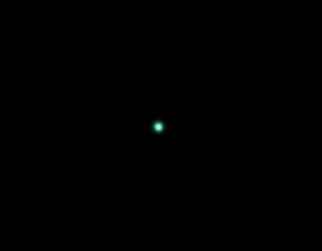
In amateur size telescopes, Uranus appears as a small greenish featureless disk. Even the images of Uranus that were taken by the Voyager spaceprobe did not show any details on the planet's disk. On the date that this image was taken, Uranus was shining in the early morning sky at magnitude 5.9, with a size of 3.4 arc-seconds. Uranus brightens to magnitude 5.7 near opposition, and may be glimpsed with the naked eye under very dark skies. At its maximum size, it is 3.7 arc-seconds in apparent diameter.
Uranus is a gas giant planet about the size of Neptune. Uranus was discovered by William Herschel in 1781. At first, Herschel thought he had discovered a comet, but subsequent observations showed that it displayed the motion of a planet, and not a comet. Uranus was the first planet discovered in modern times, because all of the planets from Mercury out to Saturn are readily visible to the naked eye and were known to the ancients. Herschel wanted to name the planet "George" after King George, but the proposed name was not accepted. Neptune was discovered after the motion of Uranus indicated that another planet seemed to be perturbing the orbit of Uranus.
This image was taken from my back yard in Scottsdale, Arizona, using a Mewlon 210 telescope at prime focus with an SBIG ST-8E and a CFW-8.
Constellation: Aquarius
RA: 22h 18m 31.5s Dec: -11d 18' 49"
May 5, 2003
Image by Sid Leach
Scottsdale, Arizona
Recent Images.
Complete list of images.
Description of equipment used to acquire images.
Home
Feedback and comments should go to Sid